What is faceting|The difference between Edo faceting, Satsuma faceting, and Otaru faceting and its charm

Faceting is one of Japan's traditional glass craft techniques. A rotating metal wheel is pressed against the surface of the glass with an abrasive to create a unique design by grooving and polishing. Products made with this technique are also called faceted. The name "faceted glass" is said to derive from "kiriko-gata," which refers to the shape of a cube with its corners cut off.
This article focuses on the three facets that we carry in our showroom, Edo faceted glass, Satsuma faceted glass, and Otaru faceted glass, and discusses the differences and attractions of each.
Article
History of faceting

Before describing each facet, we will discuss the history of faceting.The introduction of faceted glass technology began when cut glass was brought to Japan by missionaries during the Age of Exploration in the 16th century. Later, glass production began in Nagasaki, and in the Edo period (1603-1867), glass was produced in Osaka, Edo, Satsuma, and other areas throughout Japan.
Japanese faceting developed independently based on Western techniques. There are differences in raw materials and manufacturing methods. In Japan, lead glass was used, and the technique of creating cut patterns by manual friction continued until the early Meiji period.
type of faceted glass from Edo
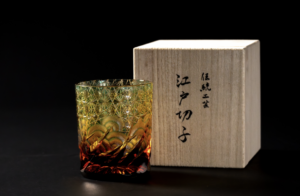
Edo faceting is a faceting technique that originated in the town of Edo in the late Edo period. Edo faceting, which developed from the culture of the common people, is characterized by its delicate and beautiful carving techniques.
> >Click here for sales website
feature
Glass Structure
Edo faceting is a double-layered structure of thinly colored glass blown into a glass mold and then overlaid with a layer of clear glass.The following is a list of the most common problems with the
Cutting Features
Edo faceting is characterized by clear, thin cut lines. The contrast between the transparent glass and colored glass is sharp and clear.The following is a list of the most common problems with the
color
Although today's Edo faceting is characterized by a wide variety of colors, when it was first made in the Edo period, it was mostly colorless and transparent.
sense of touch
The cut is deeply dug in for an edgy, tactile feel.
design
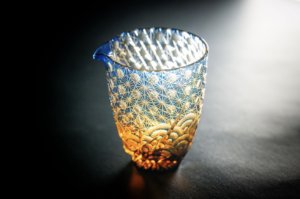
Edo faceting has a variety of patterns, each with its own meaning. Typical patterns include the igoko motif, kikutsugi motif, hexagonal kagome motif, octagonal kagome motif, chrysanthemum motif, hemp leaf motif, bamboo leaf motif, arrowhead motif, cloisonne motif, and tortoiseshell motif. These patterns have good luck and traditional meanings and are popular as gifts.
Satsuma cut glass (type of faceted glass)
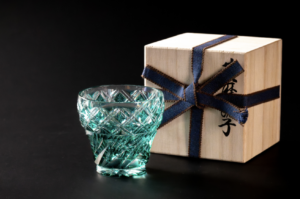
Satsuma faceting was born in the Satsuma domain (present-day Kagoshima Prefecture) at the end of the Edo period. Unlike Edo faceting, it initially developed as a business under the direct control of the clan.
> >Click here for sales website
feature
Glass Structure
Satsuma faceting uses a unique process of layering two layers of clear glass and colored glass.1. This increases the overall thickness of the product, giving it a sense of weight when held in the hand.
Cutting Features
The greatest feature of Satsuma faceted glass is a unique gradation called "Bokashi".1. The boundary between the cut and the color is blurred, giving the overall impression of blurriness.
color
Satsuma faceted glass is made by covering transparent glass with colored glass. By cutting, colored areas and transparent areas are created, creating an exquisite gradation.
sense of touch
Satsuma faceted glass has a unique and comfortable feel to it, with a gurgling texture and a sense of heaviness to the touch due to the increased thickness of the glass.
design

Satsuma faceting also has its own unique patterns. Typical examples are the ring knot pattern, Satsuma stripes, fish pattern, stepped sword and chrysanthemum pattern, hobnail, octagonal baskets, hemp leaf pattern, chrysanthemum flower pattern, and tortoise shell pattern. Many of these patterns are designed using the "bokashi" technique, which is a characteristic of Satsuma faceted glass, and create a beauty with depth.
Otaru faceted glass
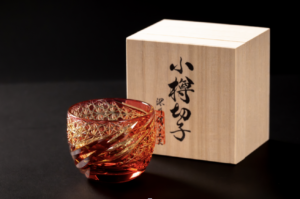
Otaru faceting is a faceting technique born in Otaru City, Hokkaido. Although it has a shorter history than Edo faceting or Satsuma faceting, it has its own unique charm.
> >Click here for sales website
feature
History
Otaru faceting developed from the glass industry that began in Otaru during the Meiji era. It was born out of the demand for durable glass products suited to Hokkaido's harsh climate.
design
The designs are characterized by Hokkaido's natural motifs. Many of the cut patterns are inspired by snow crystals and drift ice.
color
Otaru faceting is characterized by cool blue and green tones. This is inspired by the sea and forests of Hokkaido.
technique
Otaru faceting has developed in its own unique way while incorporating Edo faceting and Satsuma faceting techniques. It is characterized by the use of thick glass and deep, powerful cuts.
Representative Kiriko pattern
To begin with, how many faceted patterns are there?
In fact, there is no definite number of patterns used in faceting. Each workshop has its own emphasis on different patterns, so the number and types of patterns used vary slightly. In addition to the traditional patterns that have been handed down from generation to generation, new patterns are invented by craftsmen active today. Not only that, but the name of the crest can change depending on where it is engraved, or two crests can be superimposed to make a single crest.
Furthermore, the impression of the same pattern can be drastically changed by simply changing the width of the lines and the depth of the engraving.
Because Edo faceting alone is so profound, it is said that there are more than 15 types of patterns, even if only representative ones.
Nanako
<Illustration or Photo
The 魚子紋 is a traditional pattern inspired by a grain of fish roe. Since fish were called "魚 (na)" in ancient times, the name "魚 (nanako)" was used to read "魚 (魚)". In the faceting world, a pattern that looks like overlapping fish scales is called "魚子紋" (魚子紋), and is characterized by small grains. Also, the large number of scales makes it an auspicious pattern that wishes for prosperity and abundance for one's offspring.
Kiku-tsunagi
<Illustration or Photo
The chrysanthemum tsunagi-mon, which represents a continuous pattern of chrysanthemums by intricately intersecting vertical, horizontal, and diagonal straight lines. The finer the lines, the denser the pattern, and the more refined and sophisticated it is with its understated brilliance, making it a popular pattern. Since many fine lines need to be cut and decorated, craftsmen are required to have a high level of skill.
Chrysanthemums have the meaning of "longevity" and are recommended as gifts for Respect-for-Senior-Citizens Day, Father's Day, and Mother's Day. Also, "chrysanthemum" can be written as "kiku," which can be translated as "joy lasting long," making it a good luck charm for wedding gifts and housewarming gifts.
Rokkaku-kagome pattern
<Illustration or Photo
The Kagome motif is based on the meshes of bamboo baskets, and as the name suggests, the pattern is cut to form a hexagonal shape. The kagome pattern has long been thought to be effective in repelling evil spirits, and the hexagonal kagome also has the meaning of repelling evil spirits.
The hexagonal kagome pattern, made by combining horizontal and diagonal lines, looks like a six-pointed star from a distance. This hexagram shape is sometimes interpreted as a pattern of good luck, as it is engraved on the lanterns of the Ise Shrine. The contrast between the cut and sparkling part and the smooth texture of the uncut part is beautiful, creating an elegant atmosphere.
Hakkaku-kagome (octagonal basket pattern)
<Illustration or Photo
Hakkaku kagome-mon is another type of kagome pattern. Vertical, horizontal, and diagonal straight lines are combined to form an octagon. It is characterized by alternating octagonal sections and square cells where the straight lines intersect. Like the hexagonal Kagome pattern, the octagonal Kagome pattern is believed to be effective in repelling evil spirits, and Edo faceting with an octagonal Kagome pattern is also popular as a special gift. Compared to the hexagonal Kagome motif, the more cuts are made, the more transparent areas reflect light, giving a more glamorous impression.
Chrysanthemum pattern (Kikka)
<Illustration or Photo
The chrysanthemum crest is based on the chrysanthemum flower. The chrysanthemum family of patterns has meanings such as "longevity" and "long-lasting joy," which translates from "kiku," and the chrysanthemum crest is imbued with the same meanings. Like the petals of a real chrysanthemum, the petals are long and slender with a slightly pointed tip. Since each petal is long and slender and grows in size as they are combined, they are often used as the main feature of a work of art.
Edo faceted glass is sometimes combined with colored glass such as yellow or green, or decorated with other patterns such as hemp leaf or basket pattern. Compared to other patterns, the large size of Edo faceted glass shows the three-dimensionality of the cut surface and makes you want to look at it for a long time.
Asa-no-ha (hemp leaf pattern)
<Illustration or Photo
The hemp leaf pattern is one of the patterns with a particularly long history, having been used in clothing and works of art since before the birth of Edo faceting. Since hemp is a fast-growing plant, the meaning of this pattern has been transformed into a good omen for good health and the growth of children. When expressed in Edo faceting, there are many variations, such as a six-leaf pattern combining vertical, horizontal, and diagonal lines, or a fan-shaped pattern of elongated diamond-shaped leaves. It is a highly versatile pattern that can also be seen arranged in other ways.
Sasa-no-ha
<Illustration or Photo
The bamboo grass leaf pattern is based on the motif of bamboo grass leaves. Compared to the similar hemp leaf pattern and chrysanthemum pattern, it is narrower and has a sharp point at the tip. When the bamboo leaf pattern is cut into Edo faceted glass, many pieces are stacked on top of each other so that the pattern spreads out like a fan.
Since the overall motif is long and slender, it tends to be used for long vertical pieces such as long glasses and tumblers. Bamboos have long been used in Shinto rituals and are a plant that signifies auspiciousness*. We recommend giving Edo faceted glass with a bamboo leaf design for celebratory occasions.
*Zuishou: An omen that something auspicious will happen. auspicious omen
Yarai
<Illustration or Photo
The Yarai Mon pattern is based on the image of an enclosure called "Yarai" made of intersecting bamboos. Some Japanese houses in the past were surrounded by yarai, which are believed to have the effect of repelling evil spirits as they protect themselves from outside enemies.
Shippo
<Illustration or Photo
The cloisonne pattern is a pattern derived from Buddhist terminology. It represents the seven treasures of gold, silver, lapis lazuli, etc. that appear in Buddhist scriptures, and is characterized by the tips of the leaves being attached to each other to form a circle-like shape. Various arrangements are made in Edo faceting, including one with a star in the center, one stretched into an oval shape, and a gorgeous one with decorations in the space. Because the cloisonne pattern consists of an endless chain of interlocking rings that signify peace and perfection, it is said to represent "treasures throughout the world" and "endless prosperity of descendants.
Kikko
<Illustration or Photo
The turtle shell design is a pattern created in the motif of a turtle's shell. The design is a simple hexagonal shape and is used in various traditional crafts such as lacquerware, pottery, and kimonos. When it is used in faceted work, it is sometimes expressed by cutting, and in other cases, it is decorated only with unevenness without cutting. Turtles have long been revered as a symbol of longevity, with the saying, "A crane lives for a thousand years, and a turtle for ten thousand years. The name "tortoise" is derived from the word "happy tortoise," meaning that the blessings of the tortoise will be extended to all six directions.
Since the turtle has long been considered an animal of good fortune, Edo faceting with a turtle shell design is recommended as a gift.
cobweb print with a core
<Illustration or Photo
Unlike the coreless spider's web pattern, the center of the cored spider's web pattern is also filled with straight lines. The fine cuts are made in all directions and are so delicate that you cannot see each individual line without careful observation with a magnifying glass. The meaning of the spider's web pattern system is "to ward off nightmares," making it an attractive item that can be purchased and given as a gift as a good luck charm.
coreless spiderweb print
<Illustration or Photo
The "spider web pattern" was inspired by a spider's web, in which thin threads develop geometrically. As the name "coreless" implies, the spider's web design is characterized by a round cavity in the center of the pattern. From a distance, it looks like a lace-knit motif, giving a unique impression of a blend of Japanese and Western styles. The spider web design has the meaning of "entangling nightmares and delivering only good dreams to the owner," making it a Japanese version of a dream catcher.
Faceting manufacturing process
1. allocation
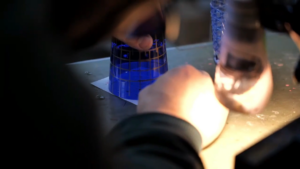
Allotment is the first step in the faceting process, in which markers are drawn on the glass surface in accordance with the design. This is an important preparation for a precise finish, and the overall balance and shape of the piece is determined at this stage.
2. coarse grinding
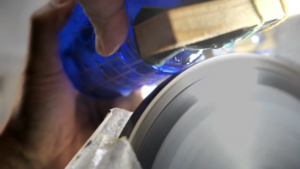
In the roughening process, the glass is roughened along the markers indicated in the allocation process. This is the main process of shaping the glass, and a rough design is formed using specialized tools. This is an important process that forms the basis for the finishing work that follows.
3. stone hanging
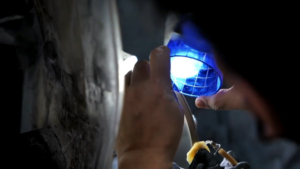
Ishikake is the process of further sharpening the surface that has been roughly prepared by rough grinding to make the design clearer. Fine grinding stones and tools are used to smooth the surface and accentuate the precise pattern.
4. polishing
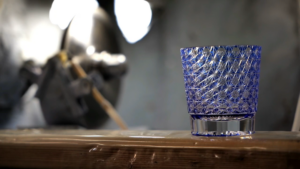
Polishing is the final finishing process to bring luster to the glass surface after it has been stoned. Polishing is done using abrasives and special machinery,Transparency and beautiful shineThe process gives the faceted surface its unique and gorgeous reflections of light. This process produces the gorgeous reflections unique to faceting.
Although there are differences in the detailed techniques and finishes between Edo faceting, Satsuma faceting, and Otaru faceting, the basic manufacturing process can be summarized in these four steps.
Edo faceted glass, Satsuma faceted glass, Otaru faceted glass, which you can feel in Sapporo
The beauty of Edo faceted glass, Satsuma faceted glass, and Otaru faceted glass can be enjoyed at "Japanese Modern N6 Kita Maruyama" located in Kita Maruyama, Sapporo City.You can actually see and feel the product in your hands.The faceted glass is famous for its traditional craftsmanship. Faceting is a renowned traditional craft, but the differences in texture and cut of each piece cannot be fully conveyed through photos and videos. This space allows visitors to directly compare facets from all over Japan while in Sapporo.
Only in the showroom can you experience the sparkling transparency of the faceted pieces through the light, the delicate cut to the touch, and the beauty of the craftsmanship up close and personal. At WA-MODERN N6, you can enjoy the individuality of each faceted piece while actually holding it in your hand.
We hope you will enjoy the charm of traditional Japanese crafts in Sapporo.
summary
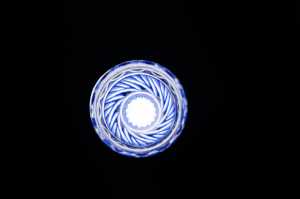
Faceting is one of the most fascinating techniques in Japanese glass art. Edo faceting, Satsuma faceting, and Otaru faceting each have their own unique history and characteristics, reflecting the culture and techniques of each region of Japan. These facets are not merely beautiful crafts, but are valuable embodiments of Japanese culture and history.
